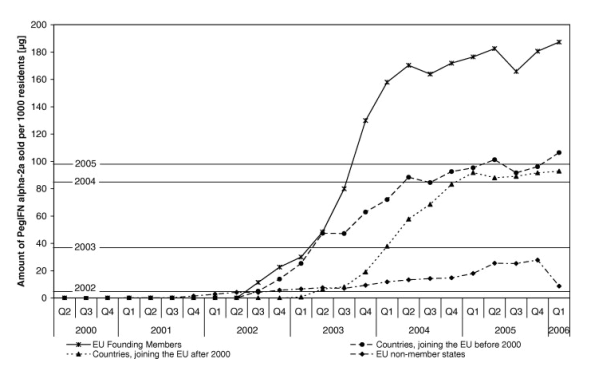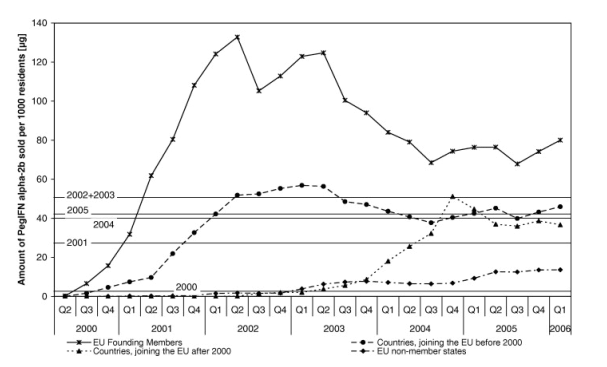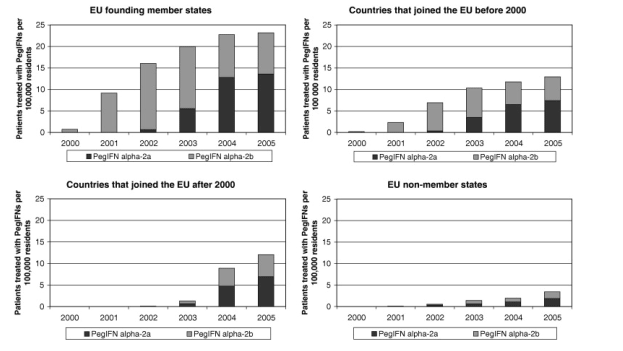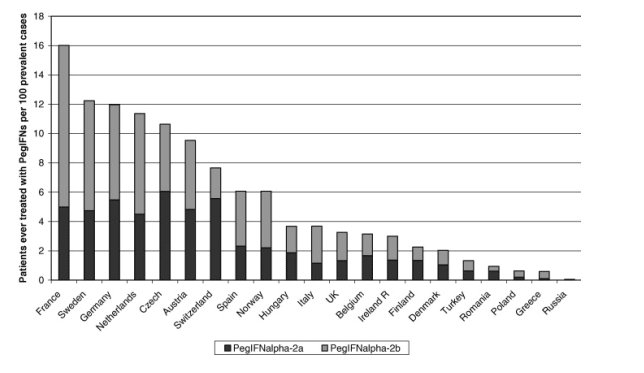| |
Market uptake of new antiviral drugs (Peginterferon + Ribavirin) for the treatment of hepatitis C
|
| |
| |
Journal of Hepatology June 2008
Beate Lettmeier1, Nikolai Muhlberger1, Ruth Schwarzer1, Gaby Sroczynski1, Davene Wright2, Stefan Zeuzem3, Uwe Siebert12
Received 18 January 2008; received in revised form 28 March 2008; accepted 16 April 2008. published online 29 May 2008.
"peginterferon market uptake and market access was found to vary considerably across 21 countries in the WHO European region suggesting inequities in access to optimised therapy. Poor market access was especially common in low-resource countries. In addition to budgetary restrictions, national surveillance and treatment policies can possibly explain market access variation."
Uncorrected Proof
4. Discussion
Our study is the first to systematically assess and compare the market uptake of and access to peginterferons - in combination with ribavirin the state-of-the-art drugs for the treatment of chronic hepatitis C [9], [35] - across a broad selection of countries of the WHO European region. In contrast to our work, previous publications estimating country-specific hepatitis C treatment rates from sales data neither described the algorithm used to convert sales into patient numbers nor did they specify the drugs included in the calculations [16], [17].
The differences in market uptake across the surveyed countries can be partially explained by different launch dates. However, our results suggest that delays in market launch and uptake are primarily related to budgetary limitations. Sales rates are low, especially in countries where the reimbursement of treatment costs is restricted [20]. Low sales rates are also observed where physicians do not prescribe state-of-the-art treatments, which may be due to the lack of financial incentives, inadequate knowledge or outdated national guidelines.
The proportion of HCV patients treated with peginterferon also varied across countries. Under-detection of prevalent cases should be recognised as a main reason for non-treatment. In France, which among European countries most actively screens for HCV-infection, at least 40% of the infections are undetected and in other countries like Spain, under-detection is estimated to be as high as 80% [36], [37]. Overall, the high treatment rate in France seems to result from an effective prevention and management strategy, including a HCV-specific network, enhanced HCV surveillance with anonymous testing and annual awareness campaigns targeting risk groups [16], [20], [38]. By contrast, low treatment rates could be explained by ineffective case detection or drug policies that exclude the high risk group of injecting drug users from antiviral treatment [20]. Treatment recommendations for injecting drug users vary substantially across Europe, from treatment refusal to allowing treatment only under specific conditions [39]. In some countries, access to peginterferon treatment is limited by a lack of funds and restricted reimbursement [17], [18], [20]. In Romania and Poland, the costs of therapy are fully reimbursed but the number of treated patients is limited which results in waiting lists [40]. Bureaucratic hurdles in the reimbursement process and the exclusion of patients with mild hepatitis from treatment should be considered as additional explanations for the variation in treatment rates. Since peginterferons are the most effective treatment option available for patients with chronic hepatitis C [7], [41], [42], [43], limiting the access to these drugs will translate into a higher number of patients progressing to end-stage liver disease and liver cancer, resulting in additional losses of life years and quality of life, and increasing the demand for liver transplantation (Muhlberger, 2008, unpublished observations [2]).
Our study has several limitations. A basic limitation is that sales data do not necessarily reflect actual drug consumption. IMS sales data are pooled from a variety of sources, each of which is surrounded with uncertainty. Not all drug distribution channels are covered in an audit. Data on rebates and free packs depend on the country and are not always available, leading to misestimation of the market [personal communication]. Additionally, during our study period a considerable number of patients from different European countries were enrolled in clinical trials where antiviral drugs were provided for free and therefore may not be captured by sales statistics.
Further limitations exist around uncertain assumptions and parameters of our algorithm used to convert sales into patient figures. One assumption was that there was no relevant off-label use of peginterferons within our study period. This may lead to an overestimation of the number of patients treated. Although this assumption was generally supported by the results of our expert survey, it might not hold for all countries. For example, peginterferons are also administered to patients with hepatitis D in Turkey, which is more frequent than hepatitis C in some areas [40]. Our algorithm also neglected to account for patients treated more than once, which also leads to an overestimation of the number of patients ever treated with peginterferon. Additionally, the algorithm might not reflect actual practice patterns in all countries. In particular, treatment stopping rules may have been introduced at slightly different dates within and across countries. For example, according to our expert survey, the 12 week early stopping rule was not applied before 2006 in Turkey [40]. However, sensitivity-analyses on the time of introduction of new stopping rules showed robust results.
Parameters of our conversion algorithm extracted from clinical trials may not apply to the general population due to patient selection. In general, our analysis did not consider co-morbidities, which have an influence on the duration and dosage of treatment. HCV genotype distribution and average body weight were derived from an international patient chart audit [30] that was restricted to selected participating European countries and therefore, might not reflect the real European average. In particular, the use of an average genotype distribution with 66% genotype 1/4 and 34% genotype 2/3 infections must be recognised as a major limitation. Although this may not strongly bias the estimated overall treatment rate in the 21 countries, it yields inaccurate results for individual countries where genotype distribution deviates from the average. However, as representative country-specific studies on genotype distribution are lacking for most of the included countries, an average regional estimate had to be used in order to derive treatment rates for all countries. According to available data, specifically in Turkey [44], [45], [46] and Romania [47], more than 90% of the patients are infected with HCV genotype 1/4. Because treatment for genotype 1/4 requires more drugs than treatment for genotype 2/3, our treatment rates for Turkey and Romania are overestimated. On the other hand, in Scandinavia [48], [49], [50], [51], [52], Denmark [53] and the UK [54], fewer than 66% of the hepatitis C cases are attributable to genotype 1/4, causing a downward bias in estimated treatment rates. In the case of dose reduction, we assumed a 50% reduction of the original dose [33]. Today, however, peginterferons are likely dosed carefully with less cases of dose reduction or minimised dose reduction due to the fact that some occurring side effects, especially depressions, can be managed better [9], [55], [56]. Overestimating dose reduction causes an upward bias. However, this potential error is reduced by the fact that the API already purchased has to be discarded and cannot be administered to other patients. For the same reason, the bias introduced by non-compliance related to already prescribed pharmaceuticals is likely to be small. Exact data on treatment duration in the case of premature stop and time undergoing reduced dosage treatment were not available from clinical trials. Therefore, these parameters were considered highly uncertain. However, varying the parameters within realistic ranges in one-way sensitivity analyses did not cause relevant changes in the ATPD estimates. Finally, the uncertainty of prevalence data used to derive prevalence-adjusted treatment rates must also be recognised as a limitation (Muhlberger, 2008, unpublished observations [2]).
Although our results allow for the ranking of countries in order of market access, it is not possible to quantify the degree of potential over- or under-treatment because there is a multitude of reasons why prevalent cases might not have been treated with peginterferon. Firstly, due to the slow and frequently asymptomatic progress of the disease, not all prevalent cases are already detected. Secondly, of the detected cases, about two thirds are either not treated due to contraindication or current drug abuse, or do not require treatment because of old age or less advanced disease [57]. Thirdly, patients might be non-compliant or have declined antiviral treatment due to fear of becoming stigmatized or of treatment side-effects impairing their quality of life [17], [58], [59], [60], [61], [62], [63], [64], [65]. Fourthly, patients might have already been successfully treated with standard interferons. Finally, in some cases, patients who fulfil treatment criteria and want to be treated do not have access to treatment. Thus, to draw final conclusions on over- or under-treatment, a Pan-European decision-analytic model should be developed to determine the fraction of not yet successfully treated but treatable patients among those ever diagnosed with HCV. This will help to identify countries and populations with inadequate access to antiviral treatment compared to the actual need.
In conclusion, peginterferon market uptake and market access was found to vary considerably across 21 countries in the WHO European region suggesting inequities in access to optimised therapy. Poor market access was especially common in low-resource countries. In addition to budgetary restrictions, national surveillance and treatment policies can possibly explain market access variation. Although our results allowed for the ranking of countries in order of market access, further Pan-European modelling is needed to draw final conclusions about potential under-treatment.
ABSTRACT
Background/Aims
Peginterferon plus ribavirin is the state-of-the-art antiviral therapy for prevention of serious complications of hepatitis C. Our aim was to compare market uptake of and access to these drugs across Europe.
Methods
We collected launch and sales data for peginterferons for 21 countries in the WHO European region and compared country-specific sales rates. Additionally, we converted sales figures into patient numbers and related those to country-specific hepatitis C prevalence, taking into account genotype distribution, patient characteristics and practice patterns.
Results
Peginterferon sales rates differed considerably across countries. The earliest, most rapid and highest adoption rates were in EU founder states, followed by EU members that joined after foundation, and EU non-member states. Most new member states showed a marked increase in sales. By the end of 2005, approximately 308,000 patients had been treated with peginterferons in the 21 countries evaluated. The number of patients ever treated ranged from 16% of prevalent cases in France to less than 1% of cases in Romania, Poland, Greece and Russia.
Conclusions
Peginterferon market uptake and access differed considerably across Europe, suggesting unequal access to optimised therapy. Besides budget restrictions, national surveillance and treatment policies should be considered as reasons for market access variation.
1. Introduction
Hepatitis C virus (HCV) infection is a major cause of chronic hepatitis, end-stage liver disease, liver cancer and liver transplantation worldwide [1]. The virus led to an estimated 86,000 deaths and 1.2 million disability adjusted life years (DALYs) in the WHO European region in 2002 (Muhlberger, 2008, unpublished observations [2]). Prevalence in the countries of the WHO European region ranges from 0.1 to 4.5%. About 20% of infections progress to cirrhosis and end-stage liver disease within 10-20 years [3]. Currently, only viral eradication by drug therapy can prevent progression. Standard interferon combined with ribavirin results in an overall sustained virological response in 45-47% of patients [4], [5], [6]. With the recent introduction of pegylated interferons combined with ribavirin, success has improved to 54-63% of patients [7], [8], [9], [10], [11]. Although the current state-of-the-art treatment of peginterferons combined with ribavirin is costly, it sometimes requires prolonged treatment duration [12] and is not effective in all patients, several HTA reports and cost-effectiveness studies weighing all short- and long-term benefits and risks have shown a clear advantage over combination therapy with standard interferons [7], [13], [14], [15]. However, it seems that not all patients who are eligible for antiviral treatment will receive treatment [16], [17], [18], [19]. There may be inequities in health care and access to therapy, as well as a lack of quality and quantity in service delivery due to socio-economic and political factors [12], [16], [17], [20], [21], [22], [23]. The aim of our study was to compare the market uptake of peginterferons across countries of the WHO European region as one of many indicators for quality of health care in the field of hepatitis C.
2. Materials and methods
We adopted a stepwise approach to address the following research objectives: (1) To collect European sales and launch data for peginterferon alpha-2a and alpha-2b used as the latest standard in the antiviral treatment of chronic hepatitis C, (2) To analyse the market uptake of peginterferons from the point of introduction and describe differences across countries, and (3) To estimate the number of patients with hepatitis C ever treated with peginterferon and compare access to this treatment across countries.
Our investigation focuses on peginterferon, the main component of the current state-of-the-art combination therapy. Ribavirin was disregarded, as it is not exclusively used in combination with peginterferon, but also in combination with standard interferon [24], [25], [26], [27], [28]. Our evaluation focuses on 21 countries in the WHO European region which were aggregated into four categories for more concise result dissemination: (1) EU founding members: Belgium, France, Germany, Italy and the Netherlands; (2) Countries that joined the European Union before 2000: Austria, Denmark, Finland, Greece, Ireland, Spain, Sweden and the UK; (3) Countries that joined the EU after 2000: the Czech Republic, Hungary, Poland and Romania; and (4) EU non-member states: Norway, Russia, Switzerland and Turkey.
Our data analysis was performed in three steps. First, we calculated the amount of hepatitis C-related active pharmaceutical ingredients (API) sold. In the second step we calculated numbers of patients treated and standardised the results by population size of each country. Finally, we adjusted numbers of patients treated for country-specific HCV prevalence.
All calculations are based on quarterly sales figures provided by IMS Health [29], a global source for pharmaceutical market intelligence that combines data from different sources such as hospitals and retailers. Sales figures were collected for the time period from drug launch until the end of 2005. The amount of peginterferon alpha-2a and alpha-2b was calculated by multiplying the number of standard units (SU, i.e., one vial or, syringe) by the respective dosage (D) of the SU. The total API per quarter for each quarter (q) and pharmaceutical (p) was calculated as the sum over the different pharmaceutical forms and dosages.
To convert sales figures into patient figures, the amount of API sold was divided by average total patient doses (ATPD), which quantify the average amount of drug used for the treatment of a single hepatitis C patient. We assumed that there was no considerable off-label use of peginterferon. The conversion was performed separately for both peginterferons, and results were combined to derive the total number of patients treated with peginterferon.
To calculate drug-specific ATPDs, we constructed a probability tree-based calculation algorithm that accounted for genotype distribution, early stopping rules, average body weight, unscheduled treatment stops and dose reductions. Practice patterns were obtained from international treatment guidelines. To check for relevant variations in local practice patterns and peginterferon off-label use, we surveyed members of an international hepatitis C expert panel (see acknowledgements).
For each peginterferon, ATPDs were determined separately for time periods before and since 2003, which differed by early stopping rules, and for genotypes 1/4 and 2/3. Genotype-specific ATPDs were combined as a weighted mean using genotype proportions as weights. Within each genotype, we considered four groups of patients: (1) patients who stopped treatment before the cut-off time of early stopping rules, (2) patients who stopped treatment at the cut-off time of early stopping rules due to lack of early virologic response (EVR), (3) patients with EVR who stopped treatment before regular end of treatment, and (4) patients treated for the entire treatment duration with an intended duration of 48 weeks for genotype 1/4 and 24 weeks for genotype 2/3. In addition, we adjusted each of these four groups for their respective dose reductions.
Parameters for genotype distribution (GT1/4: 66%, GT2/3: 34%) and mean bodyweight of HCV patients (71kg) in Europe were obtained from an international patient chart audit [30]. We did not consider different genotype distributions within Europe. EVR rates for patients with genotype 1/4 used to mimic early stopping rules were pooled from published major clinical trials [31], [32]. Between 2000 and 2003, the stopping criteria was virus negativity at week 24 (pooled EVR: 64%). Since 2003, the stopping criteria was a 2-log drop in virus load assessed at week 12 (pooled EVR: 76%) [1], [33]. No early stopping rules were used for genotype 2/3. Additionally, we considered treatment discontinuations and dose reductions due to adverse events. Both peginterferons were assumed to be equally safe and tolerated. The pooled probability of treatment discontinuation (unrelated to early stopping rules) reported in trials was approximately 7% and 10% per 24 weeks in study arms with 24 and 48 weeks of treatment, respectively [10], [34]. Dose reductions occurred in 35% of patients with 48 weeks of treatment (GT 1/4) and 28% with 24 weeks of treatment (GT 2/3) [10], [34]. In the case of dose reductions, we assumed the original dose was reduced by approximately 50%, which reflects the minimum dose reduction recommended in the Swedish guideline [33]. Statistical calculations were performed in Excel (Microsoft Corp., Redmond, WA, USA) and TreeAge Pro Suite 1.6 (TreeAge Inc., Williamstown, MA, USA).
3. Results
Peginterferon alpha-2b was developed and launched earlier than peginterferon alpha-2a in most of the 21 countries [29]. Peginterferon alpha-2b was launched in the Netherlands, Germany, Sweden, the UK, Austria, Finland, Ireland and Norway in 2000, in Greece, Russia, Italy, Spain, Denmark, Switzerland, Belgium and Poland in 2001, in Romania and the Czech Republic in 2002 and in Hungary, France and Turkey in 2003. Peginterferon alpha-2a was launched between 2002 and 2003 in most countries. Sales of peginterferon alpha-2a in Norway and Switzerland started earlier in November 2000 and September 2001, respectively. Turkey, Poland and Belgium were the last to launch peginterferon alpha-2a in the second half of 2003.
In total, about 684millionȶg of peginterferon alpha-2a and 612millionȶg of peginterferon alpha-2b were sold up to the end of 2005 in the 21 countries. To compare the development of market uptake across country categories, the amount of API sold quarterly per 1000 residents since market launch was analysed.
Fig. 1 illustrates the market uptake of peginterferon alpha-2a. The earliest, most rapid and highest increase in peginterferon alpha-2a sales rates is observed in the EU founder states, followed by countries that joined the EU before 2000, countries that joined the EU after 2000, and EU non-member states. Except in EU non-member states, sales figures steadily increased to a plateau in 2005. In order to describe marketing delays, sales figures were contrasted against reference lines representing the average quarterly amount of API sold per 1000 residents in each year across all countries. Sales rates in EU founder states exceeded the 2003 reference line in the second quarter and the 2004 and 2005 reference lines in the last quarter of 2003. Countries that joined the EU before 2000 reached the 2003 reference line at the same time, but exceeded the 2004 and 2005 reference lines about 6 and 18 months later, respectively. The new EU countries reached the year 2004 reference with a delay of 15 months and did not reach the year 2005 reference line within the observation period. Sales figures in this country category increased rapidly in 2004, when the Czech Republic, Hungary and Poland joined the EU. Aggregated sales figures for EU non-member states remained below the average sales rates in 2003, but sales rates in this category are heterogeneous with low rates in Russia and Turkey and higher rates in Switzerland. A comparison of country-specific sales indicates that since mid-2004, peginterferon alpha-2a sales rates were highest in France, where it was not launched until April 2003. Russia, Greece and Poland were the countries with lowest sales rates. Romania was the country with highest sales rates among the new EU member states.
Fig. 1. Amount of peginterferon alpha-2a [ȶg] sold quarterly since market launch per 1000 residents by country category. The reference lines represent the average amount of API sold per quarter and 1000 residents in the 21 countries of interest.

Fig. 2 displays the development of peginterferon alpha-2b sales rates. The ranking of the four country categories regarding speed and volume of market uptake from time of first launch is similar to that of peginterferon alpha-2a. In the EU founder states, peginterferon alpha-2b sales markedly increased in 2000 and 2001, reached a maximum in 2002 and decreased after the introduction of peginterferon alpha-2a. In the countries with delayed market uptake, the effect of peginterferon alpha-2a introduction is less pronounced. Countries with highest peginterferon alpha-2b sales rates are France, Italy and Spain. Lowest sales rates are observed in Russia and Greece.
Fig. 2. Amount of peginterferon alpha-2b [ȶg] sold quarterly since market launch per 1000 residents by country category. The reference lines represent the average amount of API sold per quarter and 1000 residents in the 21 countries of interest.

To compare the access to peginterferon treatment across countries, sales figures were converted into the number of treated patients. Based on the assumed genotype distribution, the conversion algorithm yielded an average duration of peginterferon treatment of 32 weeks. ATPDs derived for peginterferon alpha-2a and peginterferon alpha-2b in the period with a 24-week early stopping rule before 2003 were 5213ȶg (5902ȶg for GT 1/4, 3877ȶg for GT 2/3) and 3085ȶg (3492ȶg for GT 1/4, 2294ȶg for GT 2/3), respectively. Respective ATPDs for the subsequent period 2003-2005 with a 12 week early stopping rule were 5193ȶg (5871ȶg for GT 1/4, 3877ȶg for GT 2/3) and 3072ȶg (3474ȶg for GT 1/4, 2294ȶg for GT 2/3).
Based on our calculation up to the end of 2005, 209,000 patients were treated in the five EU founding countries, 64,000 in the eight countries that joined the EU before 2000, 18,000 in the four new EU member states and 17,000 in the four EU non-member states.
Fig. 3 shows the annual treatment rate per country category, comprising the number of patients treated per 100,000 residents stratified by type of peginterferon. On average, the treatment rate in the EU non-member states was far lower than in the EU founder states. In 2004, the new EU member states showed a seven times higher treatment rate than in the year before. After the increase, treatment rates were comparable to countries that joined the EU before 2000. In the EU member states, the annual proportion of patients treated with peginterferon alpha-2a exceeds the proportion of patients treated with peginterferon alpha-2b after 2003. In the EU non-member states, the peginterferon distribution remained balanced.
Fig. 3. Annual number of patients treated with peginterferons per 100,000 residents in the four country categories.

Fig. 4 ranks the 21 countries of interest in order of their prevalence-adjusted cumulative peginterferon treatment rate. As indicated by the graph, the proportion of HCV patients ever treated with peginterferon varies considerably across countries. France exhibits the highest treatment rate of 16% of prevalent cases. Romania, Poland, Greece and Russia are at the bottom of the rank order with less than 1% of prevalent cases treated. Averaged across all 21 countries, the prevalence-adjusted cumulative treatment rate was 3.5%.
Fig. 4. Country-specific cumulative treatment rate indicating the number of patients ever treated with peginterferons per 100 prevalent HCV cases (HCV prevalence rates in the 21 countries according to national sources: Austria 0.75%, Belgium 1.00%, Czech 0.20%, Denmark 0.70%, Finland 0.60% (estimated from neighbouring countries), France 0.84%, Germany 0.55%, Greece 1.05%, Hungary 0.80%, Rep. Ireland 0.71%, Italy 3.00%, the Netherlands 0.25%, Norway 0.60%, Poland 1.50%, Romania 4.50%, Russia 1.45%, Spain 1.50%, Sweden 0.50%, Switzerland 0.75%, Turkey 1.00%, United Kingdom 0.55%; Overall 1.29%. Source: Muhlberger, 2008, unpublished observations [2]) by country until end of 2005.

|
|
| |
| |
|
|
|